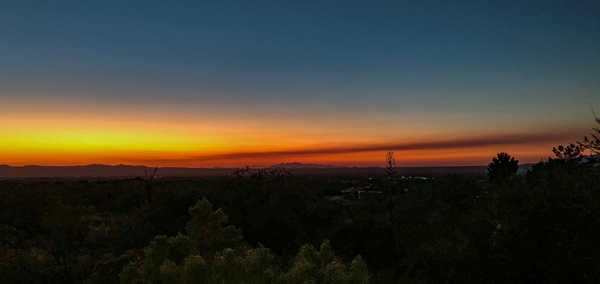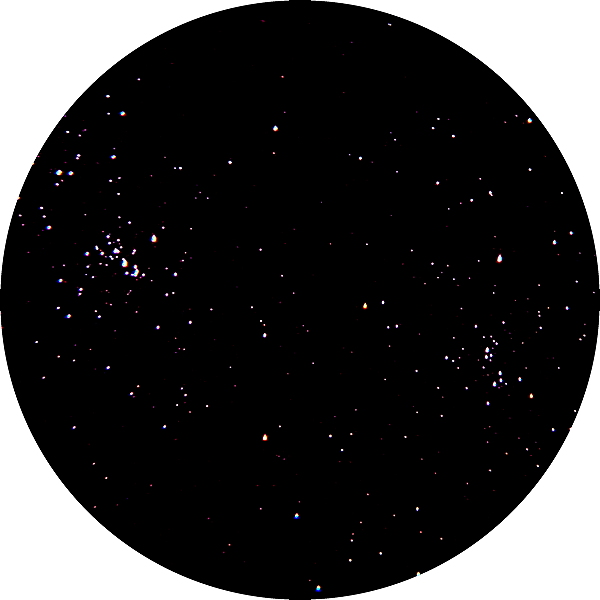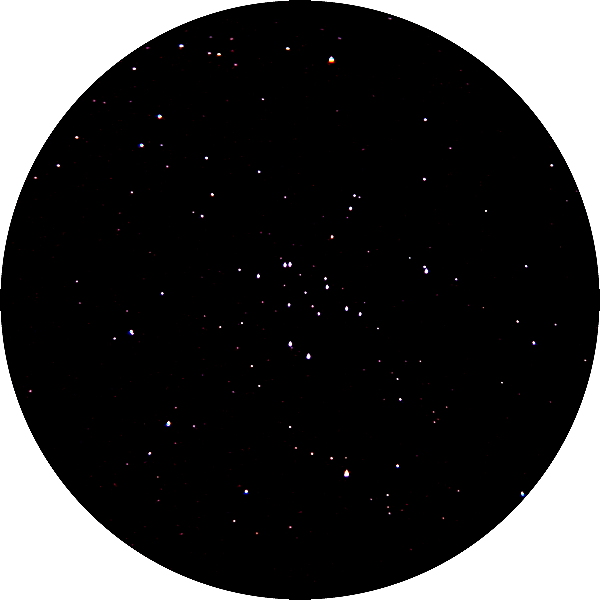iPhone Astrophotography:
Messier Globular & Open Clusters, Double Cluster
Posted: 27 October 2017
|
Open: Thursday, 26 October 2017, 1808 MST Temperature: 74°F |
Session: 1157 Conditions: Clear |
Equipment Used:
12" f/8 LX600 w/StarLock
2" 24mm UWA eyepiece
2" 30mm eyepiece
1.25" 15mm eyepiece
Camera:
iPhone 8 Plus
For the past few days, smoke, probably from wildfires in California, has been visible in the southern Arizona skies. This is how the sky looked after sunset this night as I was going to the observatory:

1813 MST: LX600 ON, StarLock OFF, High Precision OFF.
Viewed the Moon, 102X and 81X.
Mounted the iPhone 8 Plus on the 2" 30mm eyepiece using the Levenhuk adapter. Took this afocal 81X photo using NightCap Camera (ISO 32, 1/800sec):

Mounted the iPhone on the 1.25" 15mm eyepiece. Slewed to M2 (globular cluster). 1843 MST: StarLock ON. Took these StarLock autoguided, afocal 163X, images of M2 and M30 using NightCap Camera (Long Exposure, Light Boost, ISO 8000, 1/3sec, 1 minute exposure):
M2

M30

1904 MST: StarLock OFF.
Switched to the 2" 30mm eyepiece. Viewed the open cluster M52, 81X. SYNCed on it. Then viewed M103 (open cluster) and the Double Cluster (open star clusters), 81X. Slewed back to M52. Mounted the iPhone 8 Plus on the 30mm eyepiece.
1924 MST: StarLock ON. Took these StarLock autoguided, afocal 81X, images of M52 and M103, NightCap Camera (Long Exposure, Light Boost, ISO 8000, 1/3sec, 1 minute exposure):
M52

M103

This is the Double Cluster, StarLock autoguided, afocal 81X, NightCap Camera (Long Exposure, Light Boost, ISO 8000, 1/3sec, 1 minute exposure):

1935 MST: StarLock OFF.
Viewed M34 (open star cluster), 81X. Decided to image it this night.
1940 MST: StarLock ON. M34, StarLock autoguided, afocal 81X, NightCap Camera (Long Exposure, Light Boost, ISO 8000, 1/3sec, 1 minute exposure):

1942 MST: StarLock OFF. Ended imaging. Removed the iPhone and adapter from the eyepiece.
Viewed M34 (open cluster), 81X. Then viewed M15 (globular cluster), 102X. I plan to image M15 with the iPhone on a future session.
Next, viewed the nice double star Albireo and then Epsilon Lyrae (Double-Double Star), 102X. I will image them with the iPhone on the next session.
2006 MST: began closing up. 2007 MST: LX600 OFF.
|
Close: Thursday, 26 October 2017, 2014 MST Temperature: 65°F |
Session Length: 2h 06m Conditions: Clear |
On Tuesday, 24 October, I gave a talk about dark skies and a talk about my Total Solar Eclipse experience to a group in Oro Valley, Arizona. A short report is available on the Oracle Dark Skies Committee web site.
Comments are welcome using Email. Twitter users can use the button below to tweet this report to their followers. Thanks.
Cassiopeia Observatory Home Page
Copyright ©2017 Michael L. Weasner / mweasner@me.com
URL = http://www.weasner.com/co/Reports/2017/10/27/index.html
